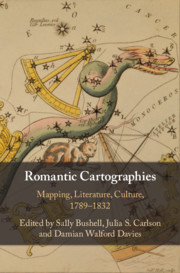Book contents
- Romantic Cartographies
- Romantic Cartographies
- Copyright page
- Contents
- Illustrations
- Notes on Contributors
- Preface
- Acknowledgements
- Introduction Romantic Cartographies
- Part I Romantic Maps, Romantic Mapping
- Part II Cartographic Encounters
- Chapter 5 Producing and Protesting Imperial Mapmindedness
- Chapter 6 Romantic Board Games and the ‘World in Play’
- Chapter 7 Carto-tactual Subjects
- Chapter 8 Wordsworth and Mandelbrot on the Coast of Britain
- Part III Beyond Romantic Cartographies
- Bibliography
- Index
Chapter 7 - Carto-tactual Subjects
Promoting the Education of the Blind in Romantic-Era France and Britain
from Part II - Cartographic Encounters
Published online by Cambridge University Press: 15 January 2021
- Romantic Cartographies
- Romantic Cartographies
- Copyright page
- Contents
- Illustrations
- Notes on Contributors
- Preface
- Acknowledgements
- Introduction Romantic Cartographies
- Part I Romantic Maps, Romantic Mapping
- Part II Cartographic Encounters
- Chapter 5 Producing and Protesting Imperial Mapmindedness
- Chapter 6 Romantic Board Games and the ‘World in Play’
- Chapter 7 Carto-tactual Subjects
- Chapter 8 Wordsworth and Mandelbrot on the Coast of Britain
- Part III Beyond Romantic Cartographies
- Bibliography
- Index
Summary
This chapter investigates the development of mapping for blind and low-vision people in France and Britain. Originally handmade for a wealthy few, tactile maps attracted the attention of eighteenth-century French intellectuals who strategically employed them to challenge the assumption that vision was necessary to the formation of civilized personhood. Blind people interacting with tangible maps of various forms and media became, in depictions aimed at the sighted, potent images of tactual subjectivity and participation in the public sphere. Beginning with Denis Diderot’s account of handcrafted maps in his Addition to the Letter on the Blind and concluding with the Scottish educator John Alston’s 1839 printed tactile map of the British Isles, Carlson shows how maps read with the fingers spurred a democratic educational movement that spread from France to America and to Britain, and, in recasting personhood, society, and nation, helped to change the status of blind people around the globe. Valentin Haüy’s embossed Essay on the Education of the Blind (1786), discussing the use of tangible maps at the world’s first school for blind children, and its translation by blind poet Thomas Blacklock, helped establish cartoliteracy as a key component of literacy and social integration.
Keywords
- Type
- Chapter
- Information
- Romantic CartographiesMapping, Literature, Culture, 1789–1832, pp. 171 - 194Publisher: Cambridge University PressPrint publication year: 2020



